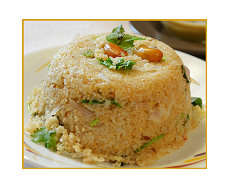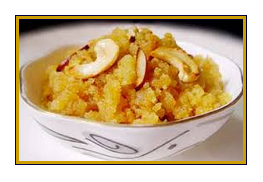 Upma
Upma
This Southern Indian breakfast, side or snack is a kind of vegetable pudding – soft and eaten with a spoon. For the many who cannot use wheat, the recipe works nicely with cream of basmati rice. The final product is a creamy vegetable dish, delicious, buttery, moist, oily, and warm. Less moisture allows a sliceable bar food later, nice for outings.
Prep Time: 20 min. Cooking Time: 15-20 min.
Serves: 4-5
Tip at the top:
In a mother’s rush or if you don’t have these, substitute 4-5 tsp curry powder for coriander, cumin, mustard, curry leaves, fenugreek, hing, even cayenne if it is a spicy one; warm gently in the ghee just to bloom the flavors before adding veggies.
Ingredients
3 c water
2 c carrots, asparagus, perhaps some summer squash, methi leaves, basil, dill, or other timely veggies
1 c farina (cream of wheat), coarsely ground semolina or cream of basmati rice
1/2 c ghee or light sesame oil
1/4 c cilantro leaves, chopped
1-2 t ground coriander seed
1 t black mustard seed
1 t cumin seeds
3 – 5 leaves curry (optional; this is not the powder but the plant)
1/2 t turmeric powder
1 t salt
1/2 tsp fenugreek seeds (optional)
1/3-1/2 t coarse ground black pepper
3 pinches hing
3 cloves garlic, minced (optional)
1/16 t cayenne pepper or 1/4 t nutmeg (optional, to taste)
6 lime wedges for optional garnish
Preparation
- Wash, trim and grate or cut vegetables into small pieces. For quick and easy, use your food processor for most of them until you have time to do more distinctive prep.
- Bring water to boil with salt and turmeric while doing step 3.
- In a medium heavy skillet roast the grain in half or more of the butter or oil, over medium heat until a shade darker, more golden, and fragrant. Stir frequently. It may look after a while like grains of sand at the seashore, with a slight froth on it.
- Gradually add the hot water to the toasted farina on lower heat at first, stirring constantly to avoid lumping and until it has the consistency of cream of wheat cereal. If this is a new technique for you, a whisk helps ensure there is no lumping. Set aside during step 4.
- In separate skillet, warm the rest of the cooking oil. When ghee is clear, add spices, such as the mustard seed, fenugreek seed and cumin. When they pop and fenugreek is toasted, add optional curry leaves, garlic, hing, ginger, and coriander powder and when fragrant, add all the vegetables, long cooking ones first. Sauté them until tender – adding a splash of water and a lid if needed to prevent drying out.
- Remove lid if you used it, and mix the farina into vegetables. Add optional pinches of cayenne or nutmeg. Add minced cilantro, reserving a little for garnish with an extra grind of black pepper when you turn it out onto a platter, plate or bowl.
- Upma may firm up to a consistency you can cut when cool, and may be used as a snack with hot tea a little later.
The fresh curry leaves are so delicious, if you have access. Or add optional basil at the end. Of course we can substitute fresh basil or dill or methi leaves for the cilantro, or long cook some onion until sweet. However it is best to choose 2 or 3 total veggies maximum, at first. Later play with American or Chinese, Thai or other cuisine’s seasonings, but be sure it is enough for mama’s agni.
Classical Ayurveda asks us to avoid lemon or other citrus for 5-6 weeks after birth, for their sour vipak and rajasic qualities. Lime has a sweet vipak and sattvic mental quality, making it suitable after about 10 days.
Recipe adapted from Rasa Mac Knight, Miriam Kasin Hospidar, Usha Lad and other wonderful cooks.
Taratoor (Tahini) Sauce
Traditionally served on falafel sandwiches (which we avoid along with other deep-fried foods during the postpartum Kayakalpa window), this sauce wonderfully complements a bowl of dahl for complete protein as a sauce over vegetables, baked yam or rice. The thinned version is suitable after the first 10 days postpartum or for second or third trimester pregnant women who are not high pittas.
Prep Time: 15 min.
Serves 4-8 (depending on other menu items)
Ingredients
1/2 c tahini (toasted)
1/4 c lime juice
1 T maple syrup
1/4 t salt
¼ c water and/or olive oil or more, to desired consistency-see options below
Preparation
- Puree ingredients well in blender. If adding water, hot or warm will work best. Adjust for taste – sour, sweet, salt, pungent, and the tahini undercurrent of bitter.
- Serve over suitable vegetables, baked yam, quinoa or rice
Comments and Tips
Add water for desired consistency. The citrus (lime) thickens the tahini surprisingly. Optionally add some olive oil also, which softens texture, helps accomplish early postpartum oleation, cools the recipe some, and combines well for taste.
Gourmet variations: 1) A little black pepper or cayenne or some freshly grated ginger or toasted garlic are particularly tasty additions. 2) A generous addition of dried dill herb, tarragon, and/or toasted cumin seeds. 3) Or add a little sweet citrus zest such as lemon, mandarin or orange peel, maybe 1-2 t minced.
Notes: You can use other sweeteners, but maple syrup complements tahini’s bitterness and heat. You can, of course, play with other nut butters or purees similarly but this taratoor sauce really sings – I love the olive oil, roasted garlic, dill weed and cumin seed version.
Always use your sesame roasted, not raw, according to Dr. Shrestha, to avoid a toxin accumulation.
 Sweet Baked Winter Squash
Sweet Baked Winter Squash
Very yummy and very easy to make, winter squashe prepared this way is so soothing for vata the second-third week and beyond. Because even winter squashes have a little astringent quality, we serve them sweet first. Here is how my mother made them – your least prep (ignore the picture!) Mama served “boats” with extra sauce in the middle.
Prep Time: 10 min. Cooking Time: 50-60 min.
Serves 4
Ingredients
1 large acorn or other winter squash
¼ c warm ghee, or as needed
¼ c your brown sugar of choice
1-2 T fresh ginger, grated
1 tsp cinnamon
1/4 tsp clove powder
1/8 tsp nutmeg
salt to taste
Tip: Use pumpkin pie spice in a rush.
Preparation
- Halve the squash lengthwise and seed.
- Melt the ghee and thoroughly brush the squash with ghee. Use enough ghee so that all pieces are all completely covered.
- Mix the extra ghee with sweetener and all the spices except salt. Brush this thick mix all over the top and leave the rest sitting in the bowl of the squash. Salt your squash.
- Add 1/8 inch of water to the bottom of the baking pan, cover lightly with another large pan or foil, and put into 400 F oven for 40 minutes.
- Check for even cooking and remove cover. Finish baking another 20-25 minutes or until veggies can be pierced easily with a fork.
Be sure your squash does not get dried out; ovens and altititudes require a cook’s attention a bit, but this should be easy and come out tender, juicy, sweet and glistening. Halve each piece to get 4 dripping servings. Remember that mama may even want black pepper with hers too, or some panchakola ghee if you skimped on the ghee! Serves well with a kitchari or a light protein, noodle and vegetable soup.
 Mother’s Sheero
Mother’s Sheero
a.k.a. Sheera – Farina Milk Halva
Cookbooks offer variations for this nourishing, easy to digest, high-protein and energy snack and we offer the use of cream of rice instead of farina for the many avoiding wheat. We also use at least 1 extra part liquid. This is best served warm and fresh. Serve after childbirth as desired, as a soothing, grounding, bowel softening and energy supportive first days’ nourishment.
Prep Time: 5 min. Cooking Time: 20 min
Serves 4
Ingredients
2 c non-homogenized whole milk (or part cream or part-all water as needed)
1/4 c ghee
1/2 c farina (cream of wheat), coarse-ground semolina flour or cream of rice
1/3-1/2 c natural sugar (light colored for this recipe)
1 -2 T sliced almonds, cashews, unsalted pistachios, charole nuts or coconut flakes
1/8 t cardamom (very best if you use crushed seeds from 3-4 pods)
1/2 t ginger or more
1/8 t nutmeg (optional)
1/16 t saffron, soaked in 1/4 c hot milk or water (optional) or
4-6 drops rosewater or vanilla (optional)
Preparation
- Bring milk or water just to boiling up in a separate pot. Take care not to let it boil over.
- Melt ghee and add grain in a heavier bottomed pan (wider pot or frying pan works best).
- Saute slowly on medium, adding ginger powder and stirring frequently. Cook for 5-10 minutes or until it turns a shade darker – golden and fragrant. Remove from heat and stir in milk (or water), stirring briskly. A whisk works well at this stage. Return to heat and cook 7 – 10 minutes stirring constantly until fairly thick. This will go more quickly if you have already boiled the milk.
- Reserving a few nuts for decoration on top, stir in the rest with sugar, cardamom, optional nutmeg, and soaked saffron. Keep turning until well cooked and the mixture begins to pull away from sides of the pan, acting like one mass. Turn off heat and add optional rosewater. Now spread in a dish and decorate with saffron (crushed, or soaked and stirred in before serving), flaked almonds, extra nutmeg sprinkle. This is oily and won’t stick much. Cut into desired shapes (squares, rectangles or diamonds) and serve warm. For a real treat later, have someone warm yours in a small frying pan, making a golden crust.
Comments and Tips
When using milk, the lighter sugar usually works best. Dark brown sugars can curdle the milk unless added carefully at the end.
About cream of rice: Eastern Indian shoppers know what they are looking for; Americans find it sometimes next to the cream of wheat or in baby cereal section in supermarkets. I prefer to wash, slow oven dry, then grind white basmati rice in our coffee grinders. It is very low maintenance and can be done in batches when you have time, giving better quality. The flavor and texture are best with basmati (not cream of brown rice). (If there is any tendency to viral infection also, minimize brown rice because of the arginine content).
For kapha or vata add ¼ teaspoon or more of dry ginger powder. Kapha dominant people, or those with congestion, should eat somewhat less of this sweet snack, and prepare it with water, and perhaps less liquid. A warning to those favoring coconut or nut milks from the box – this will feel heavy and can tax the liver – use parts, or ideally fresh coconut water or milk. The nut milks or water based will also beg a little salt in the recipe.
You can of course make a quick and easy version with fewer spices and nuts. Be sure to boil the milk while warming the farina, and your sheero will thicken up very quickly.
Recipe adapted from MataPrema Rathod, Usha Lad, Leelaben Kotecha, and others

